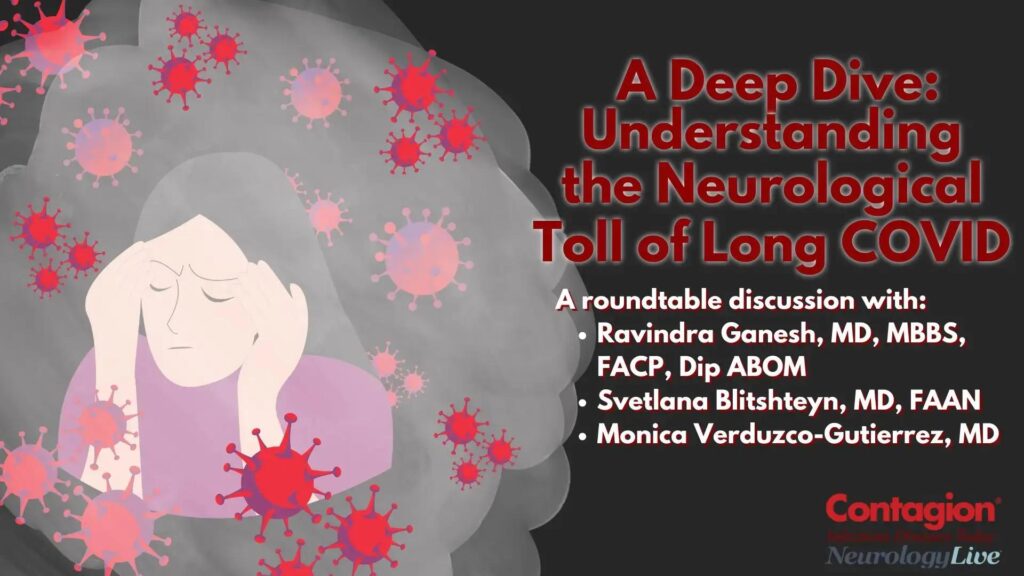Since the start of the COVID-19 pandemic, the persistence or appearance of neurologic symptoms after clearance of SARS-CoV-2 infection has become a serious health challenge for patients and clinicians worldwide. The effects of postacute sequelae of SARS-CoV-2 infection (PASC), commonly known as Long COVID, can be debilitating and persist for months after infection. Some of these symptoms can include fatigue, neuropsychiatric sequelae, sleep disturbances, sensorimotor symptoms, cognitive impairment/brain fog, hypoguesia/hyposmia, hearing loss, and ocular symptoms.
As emphasized by the research and experts in the field, currently there are no specific tests for the diagnosis of Long COVID, and clinical features such as laboratory findings and biomarkers may not specifically relate to the condition. It is important to develop and validate biomarkers for the prediction, diagnosis, and prognosis of Long COVID and its response to therapeutics. Regardless of age or preexisting health conditions, Long COVID can affect anyone, highlighting that this condition is not restricted to any specific demographic and does not discriminate, even against the healthiest individuals.
In Episode 4 of our Long COVID roundtable collaboration with NeurologyLive, clinicians noted that diagnosing Long COVID often relies on strategies used for other chronic illnesses, reflecting the challenges and limitations.
Our panel of clinicians includes:
- Ravindra Ganesh, MD, MBBS, FACP, Dip ABOM, general medicine doctor at the Mayo Clinic and leader of their Long COVID clinic.
- Svetlana Blitshteyn, MD, FAAN, clinical associate professor of neurology at the University at Buffalo Jacobs School of Medicine and Biomedical Sciences, director of the Dysautonomia Clinic.
- Monica Verduzco-Gutierrez, MD, physical medicine and rehabilitation physician, professor, and chair of rehabilitation medicine at UT Health, leader of the Long COVID clinic.
Verduzco-Gutierrez and Blitshteyn discuss the gap between research on Long COVID and the clinical tests currently available. Verduzco-Gutierrez mentions studies showing abnormal vascular markers and gene methylation patterns associated with Long COVID but notes these tests are not accessible in practice. Blitshteyn highlights the need for validated immunologic tests for clinicians and emphasizes the importance of thorough clinical evaluations. They both call for advancements in diagnostic technologies, including functional MRIs and tests for hypercoagulability, to better identify patients with Long COVID. Ganesh adds that functional testing can reveal physiological issues not seen in standard scans, highlighting the need for improved diagnostic tools.
Transcript edited for clarity.
Verduzco-Gutierrez: “Are we still talking about our wish list? Because that would be mine. We don’t have these tests available yet. But there are so many studies showing that Long COVID is real. We know that there’s pathophysiology involved. In a recent preprint from The Lancet, it was shown that there are abnormal vascular markers associated with vascular inflammation. Patients with neuropsychiatric Long COVID symptoms and cognitive changes were the ones who had these abnormalities, compared to those who did not develop Long COVID. Of course, I’m wondering if I can check any of these labs in real life. Unfortunately, they’re not available through common labs like Labcorp or Quest, so they’re not readily accessible. But at least we’re seeing differentiating factors.”
“There was another study that looked at methylation patterns of people’s genes. It gives us a clue, if certain genes methylate in specific ways, those individuals are more likely to develop Long COVID. But again, we don’t all have big labs to analyze gene methylation after infection. We also know that the complement system and inflammation are impacted in people with Long COVID. It’s nice to see we’re getting closer to having tests that show there’s abnormal pathobiology. Now, we need to make these into accessible biomarkers.”
Blitshteyn: “I agree. There’s always a huge gap between the tests available for researchers and those available for clinicians. We need to find a cost-effective way to bridge this gap. I would love to have cytokine panels and T-cell type tests available, ones we could apply to our patients. That’s been long overdue. Even before the COVID pandemic, there was a shortage of good, accessible, and validated immunologic tests, including antibody tests for autoimmune disorders that don’t show up on standard autoimmune panels. We need these tests to be available to clinicians. They need to be validated, from certified labs, and informative.”
“At the end of the day, waiting for these tests to legitimize or treat these disorders may not be practical. We’ve already dealt with other autoimmune inflammatory conditions with poor markers. For example, there’s rheumatoid arthritis with negative rheumatoid factor, and Sjogren’s syndrome with negative antibodies. It’s going to be important to categorize by subtypes, positive Long COVID patients versus negative ones. But I think ultimately, we’ll have to rely on clinical features and stratify patients based on their clinical presentations.”
Verduzco-Gutierrez: “Right now, we have the National Academy of Medicine’s definition of Long COVID, which is a clinical definition. Listen to your patients, get the timeline, and see how long their symptoms have been going on. Of course, work them up, don’t just do the basics. Be as thorough as possible, as we discussed earlier. Right now, it’s all about listening to them and taking a thorough clinical history. It’s a clinical diagnosis, and we’re going to have to accept that for the time being.”
Blitshteyn: “I think Long COVID presents a great opportunity to develop other technologies and modalities for clinical use. We need to make specialized neuroimaging and MRI sequences more available, accessible, and affordable. Functional MRI should be cheaper and more widely used. We also need tests that can identify hypercoagulability visible on MRI. Right now, when we do a 3 Tesla MRI of the brain, we often don’t see much. We do see increased white matter changes in some patients with Long COVID, but that’s not enough. We need to go further.”
“Wouldn’t it be great if this “shadow pandemic” of Long COVID spurred the development of these new technologies in clinical practice for both clinicians and patients? I’m thinking about MR spectroscopy, PET scans, spinal taps, lumbar punctures, and autoimmune profiles of cerebrospinal fluids, which we don’t typically get. “How do we assess venous outflow in the brain to check for hypercoagulability or stenosis?” Maybe the CSF isn’t draining properly in many patients. “What about the glymphatic system?” There’s so much in neuroscience we can apply in clinical practice now.”
Ganesh: “I think most of our patients look fine on anatomical scans, but when we challenge their physiology, when we stress them, that’s when we start to see the deficits. The changes show up. Functional MRIs might be one of the best approaches because patients are generally fine at baseline. But as they experience cognitive, physical, or emotional stress, that’s when their energy diminishes, and their symptoms worsen. That’s where the physiological issues often become apparent.”
“The only quote-unquote “reliable marker” for ME/CFS is the two-day CPET. I don’t like doing it because you’re essentially inducing a crash to show that the patient had a crash. I’ve done it twice in my life, both times because insurance required it for disability evaluation. But the testing in both the neurological and immunological realms is really lacking, and that’s what we’re seeing in our patients. It’s definitely high on my wish list.”








